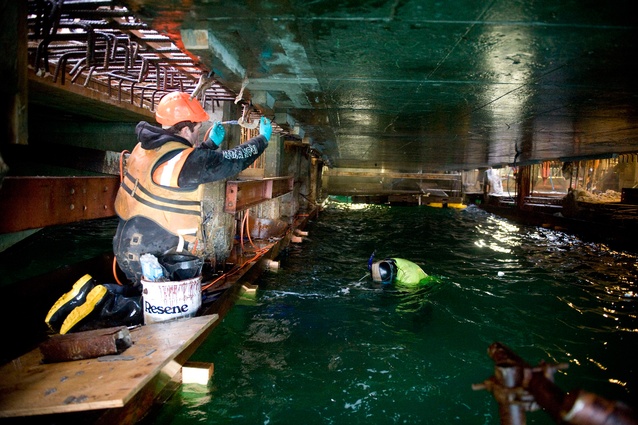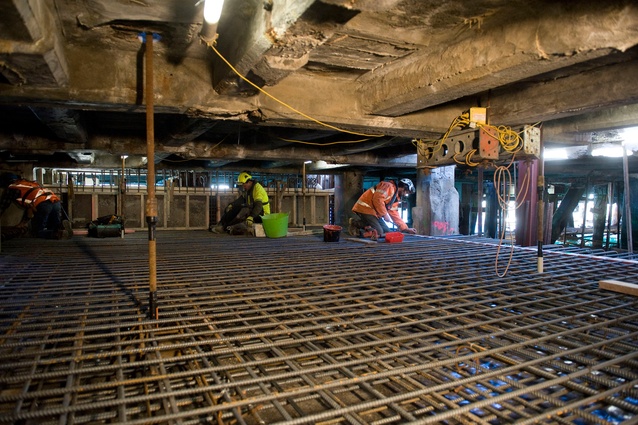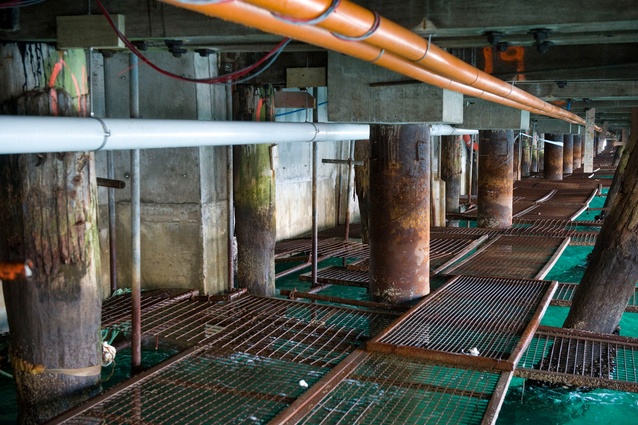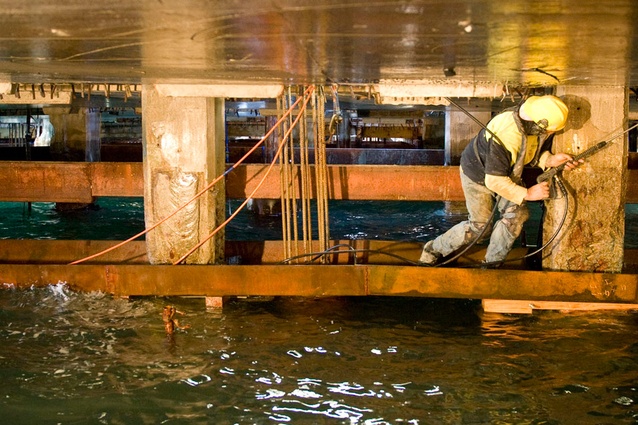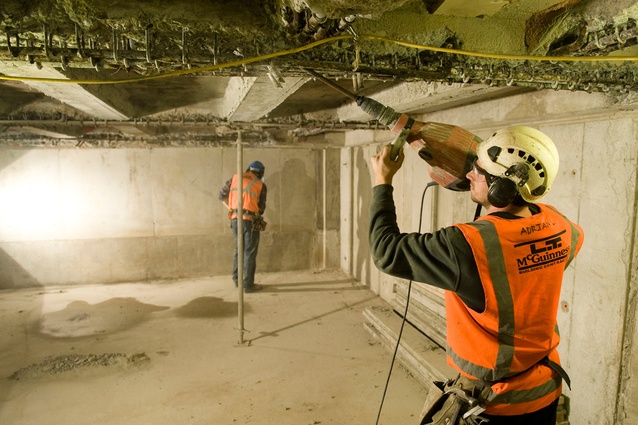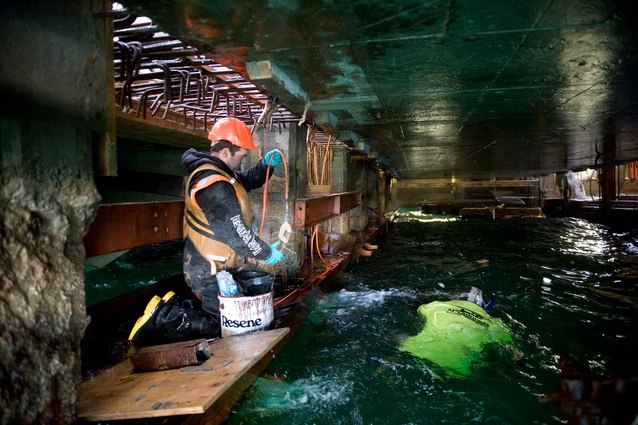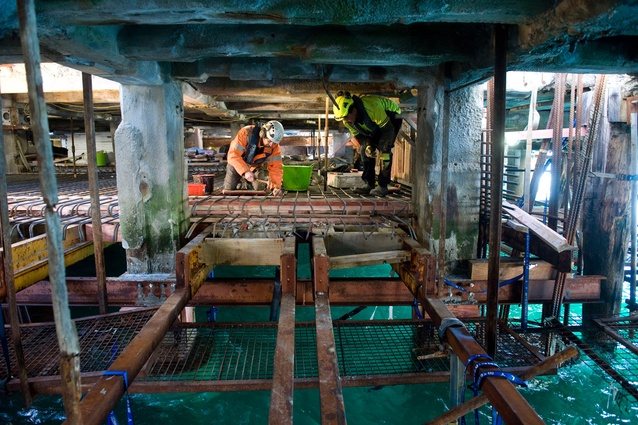A street on the water
Tides, whales, schools of fish, and carpenters in diving gear and life jackets were just some of the obstacles faced in the first stage of this mammoth project.
Time and tide wait for no man. L T McGuinness’s construction teams know exactly what that means as they approach the final stages of building the basement car park for the $100 million Clyde Quay Wharf development on Wellington’s waterfront. Currently one of New Zealand’s largest commercial construction projects, the development will comprise 76 premium apartments on the upper levels, public spaces, art works and hospitality businesses at wharf level. Designed by Athfield Architects, the complex replaces the Overseas Passenger Terminal, built in the 1960s on a wharf that dates from 1910.
Demolition and construction work began in 2012. Basement project manager Sean McGuinness and his teams have worked around the clock, fitting in with high, low and king tides, and getting up close with orcas, stingrays, schools of fish, mussels and barnacles. Life jackets are compulsory in tidal zones and armpit high waders are work gear of choice. A few have worn wetsuits and used their diving skills on site. The original wharf deck has been retained for cost and heritage reasons. As there is no crane access under the wharf rafts and dinghies are used to transport men, materials and equipment in the restricted space.
Peter McGuinness, construction manager of LT McGuinness said the construction of the basement car park was pivotal to the project proceeding. Peter was involved in planning with structural engineer, Adam Thornton from 2007 when Willis Bond & Co won the development rights for the site. Adam Thornton designed the watertight car park, which will provide around 100 car parks for tenants. The car park measures just under 200 metres long (two rugby fields) and 17.5 metres wide.
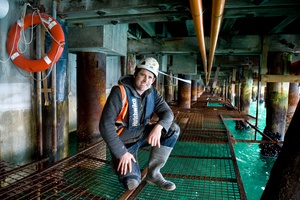
Peter and Adam formulated the idea of pouring the car park floor slabs in sections on site under the wharf then lowering them into position. The contractors tested prototypes in their yard to ensure the viability of elements such as stitch joints, carbon jackets and formwork designs. The existing concrete wharf was in a very poor state, Peter says, particularly in the tidal area, where crumbling concrete and rusted reinforcing were evident. The effects of the waves were significant during the construction phase. Interestingly a southerly storm was less disruptive than a northerly storm because of the position of the wharf in the harbour.
“We had to strengthen the existing wharf and piles, bore new piles, support the car park and new structure above, tie the existing wharf into the car park and make it water tight,” Peter says. He was involved in two resource consent hearings in 2008, which raised issues pertinent to the coastal marine environment.
Noise and dust caused by the demolition of parts of the wharf were required to be managed and marine life protected from contaminants by filter cloths. Other
issues covered included the effects on the adjoining neighbours at the marina and high-end apartments. Heritage elements were to be retained and incorporated into
the new building. Demolition of the 1910 concrete wharf required large amounts of hanging scaffolding that became submerged at high tide. The work was done by hand with jackhammers and wiresaws because machinery wouldn’t fit under the wharf.
“Early on in the process we learned that you have to make water your friend,” Sean says. “We discovered the most efficient way to get rid of the concrete X braces and beams was to float them out. We’d break the sections out and drop them into the water with large buoys, float them to the side where there was an opening and crane them out.”
The contractor used a team of four divers, who normally worked nine hours a day weather permitting. They removed marine life from piles, facilitated demolition work and strengthened the existing concrete wharf piles using carbon fibre jackets and concrete ‘donut’ jackets on the tops of the piles. The divers were experts at underwater reinforcing, fixing, formwork and pouring tremie concrete Sean says.
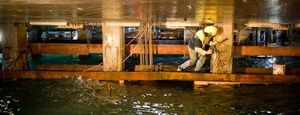
Two hundred and ten new piles were driven and bored in between the existing piles through holes cut in the wharf. The piles are between 600 mm and 1050 mm in diameter and on average 30 metres deep. Once the piles were in place teams began work on the car park floor slabs. The 32 basement precast slab sections were five metres wide and 17.5 metres long. This was determined by the spacing of the existing wharf piles, Peter says. “The specification called for 50 mpa marine grade concrete with a 300mm thick slab and the final weight of the slabs was 90 tonnes each.”
They set up formwork, comprising two sets of moveable two-tonne formwork panels, on steel ledges below the existing wharf. “We’d pour a slab [above the tide] and once it was cured we’d raise it up with jacks then pull the formwork through, winching it out between the piles,” Sean says. Then they would pour the next slab working under the wharf with standing room of only 1.2 metres. Sean’s height is 1.9 meters (6 foot 2 in). Hydrophilic seal strips provided water tightness technology along with a PVC water bar that was cast into the concrete slab.
“If any water egresses the joint the hydrophilic strip swells, blocking the water from entering,” Sean says.” We glued the hydrophilic strips in place, tied the reinforcing and poured in the stitch beams within a five-day window - the maximum period before they started swelling.” Seven lift pits and four sumps were also part of the slab. The lift shafts were lowered through a section cut out of the wharf and suspended while the slab was poured around them.
“We had to be careful; 1.5 metres was always submerged in the sea and exposed to wave action,” Sean says. “They had to be very well braced. We’ve learned that the power of the sea is absolutely immense.” When raised, the concrete slabs were suspended from eight 32mm high tensile hangers drilled through the existing 1910 wharf slab (not strong enough to take the loadings) and connected to steel beams above the deck. Slabs were lowered with synchronized hydraulic rams down 1.6 meters into their final position then stitch beams were poured to connect the pre-cast slabs into the existing wharf structure. From the side of the wharf they floated in nine metre-long bars on rafts to reinforce the stitch beams. Coordinating materials and transport on the water in a tight space around bars protruding from the slabs required complex planning.
“The stitch beam was tidal dependent,” Sean says. “We had four hours a day when it was low enough so we worked around the clock.” Stainless steel pins were drilled into the existing piles to provide the connection and the exterior walls were completed in each bay. To create dry conditions for the car park fit-out temporary cofferdams 1.6 meters high were placed across the basement car park deck. Heritage elements retained in the car park, such as the old piles and some reinstalled cross braces, will give people a sense of the building’s original history. “We believe this type of structure hasn’t been done anywhere else under a wharf in New Zealand,” Peter says.
As Sean and his teams complete the car park and extensive repairs to the underside of the wharf, others are building the more conventional structure above and interior fit-outs in the northern apartments are underway. Despite the scaffolding and machinery of construction the building already resembles a long cruise ship riding at anchor with the yachts in Chaffers Marina. Completion is targeted for mid 2014.
Watch an overview of the construction of this project below.

